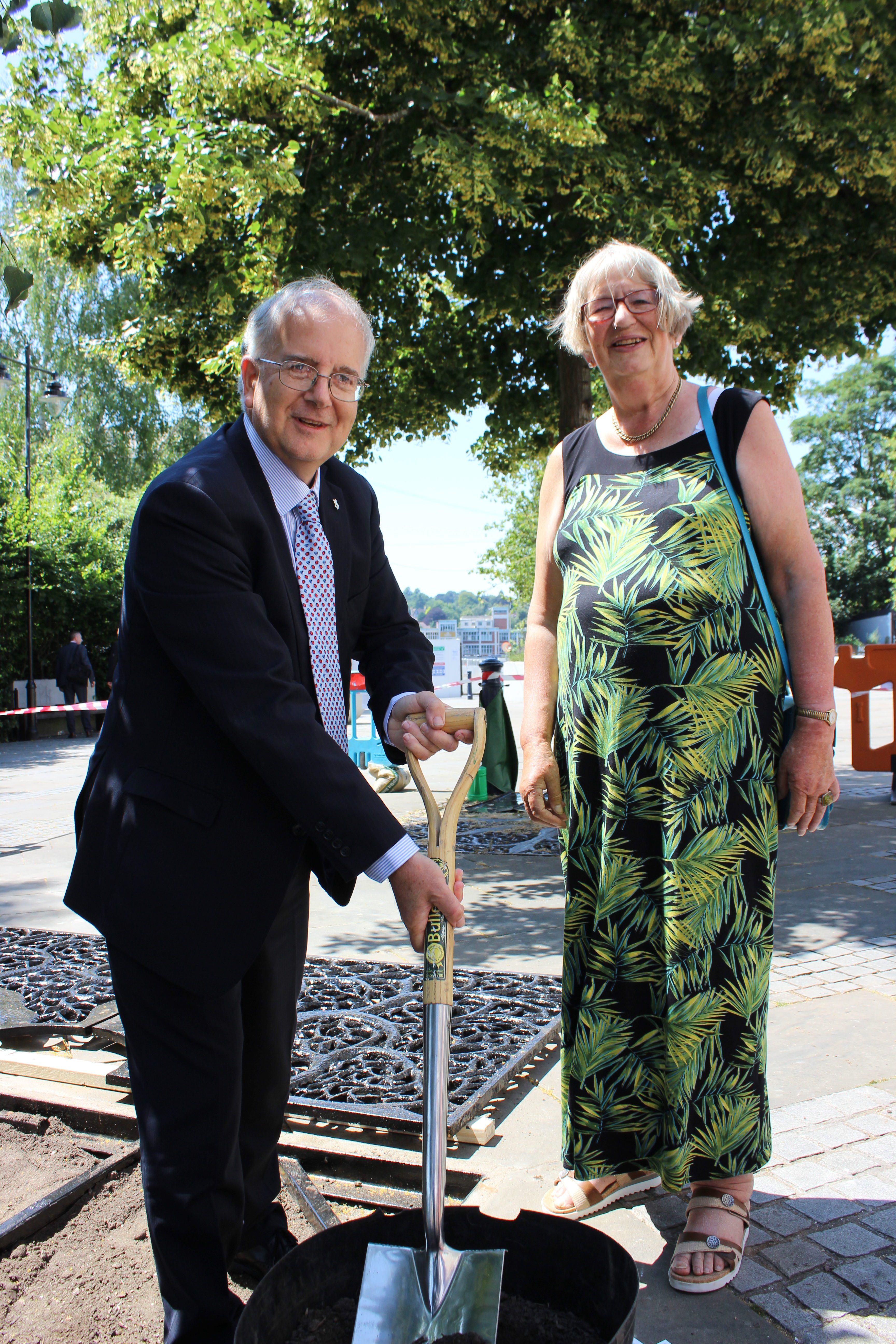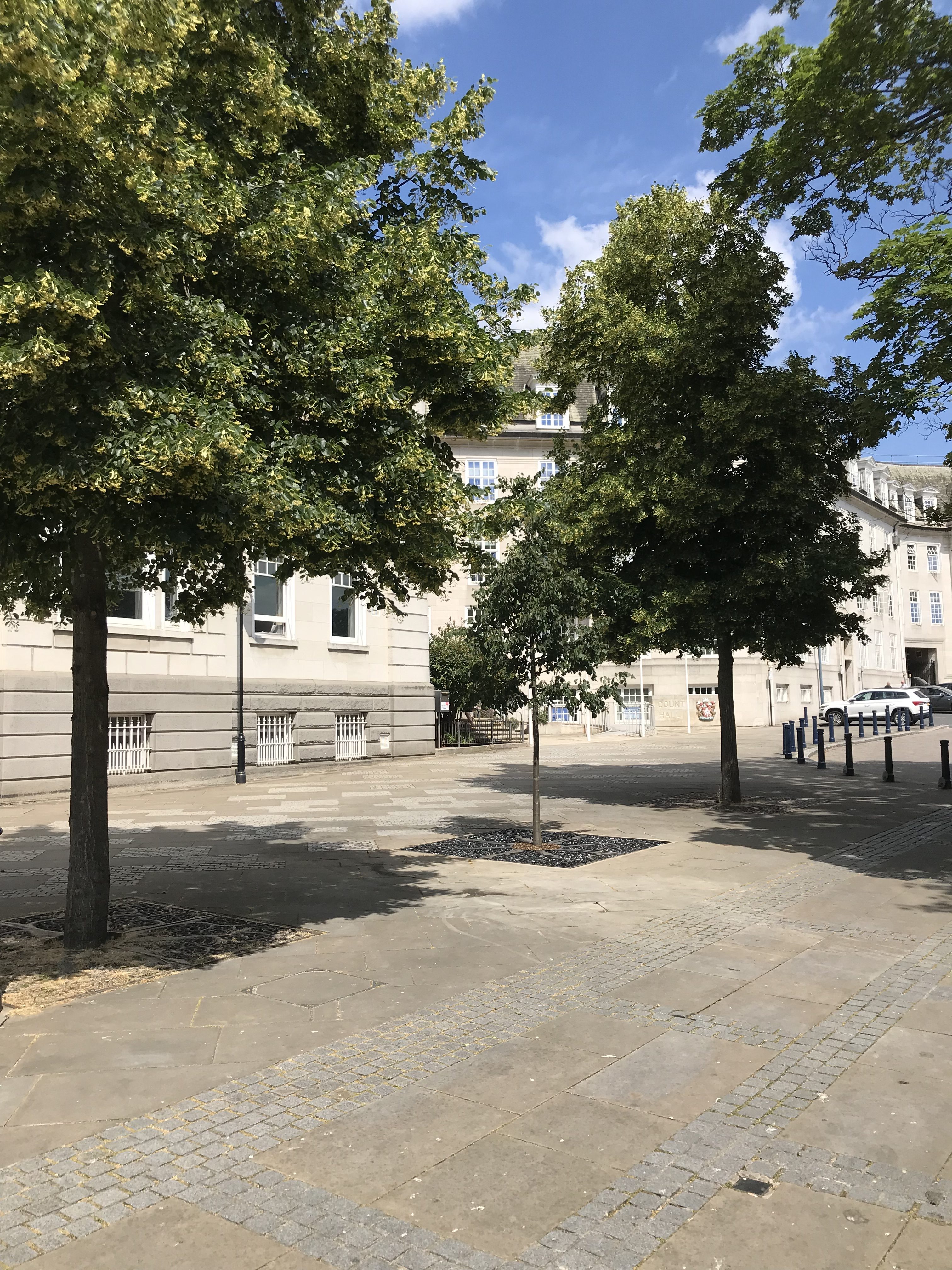Celebration for a Kent Tree Hero!

15th July 2019
Sophie Scott, a long-standing champion and tireless fund-raiser for Kent’s trees, has been recognised at a tree planting ceremony in Sessions House Square, Maidstone – county town of the Garden of England.
Tony Harwood tells us more about the event, the work Kent County Council is undertaking and the plight of the county’s trees.
On Thursday 11th July, Kent County Council’s Deputy Cabinet Member for Planning, Highways, Transportation and Waste, Michael Payne, accompanied Sophie Scott in planting a small-leaved lime tree. The tree is dedicated to Sophie in recognition of her long advocacy for a cleaner, greener and healthier Kent.
The choice of small-leaved lime is a poignant one for Kent. Pollen profiles indicate it was once our commonest tree, but it is now rare and confined to a handful of relic fragments of ancient woodland. Its sweetly perfumed blossom would once have seen our woods pulsate with bees and other pollinators, while its delicate heart shaped leaves danced in the slightest breeze.
Sadly, clearance of the Kentish wildwood, exacerbated by the vulnerability of the tree’s foliage to grazing by livestock and foresters’ favouring of more commercially lucrative tree species when undertaking woodland management, has seen small-leaved lime (and its wildlife) become rare in Kent. It is fitting then, that the county council is now working to restore a tree species people have so effectively removed from our landscape.
Sophie Scott has been actively involved in urban tree planting around Canterbury since 1997. She joined the Oaten Hill & District Society (OHDS) in 2006. OHDS subsequently merged with the South Canterbury Residents Association to form the Oaten Hill & South Canterbury Association (OHSCA). In the last 22 years, Sophie has supported and planted some 72 urban trees.
In 2010, KCC trialled a scheme whereby communities could pay for a tree to be planted by contractors and maintained by Kent Highways. Sophie responded to the call and mobilised residents house-to-house in order to raise funds. She has been doing the same thing ever since. Sophie said: –
“We were the guinea pigs! We asked for donations and were delighted to find that many people agreed. Kent Highways’ scheme has been so popular – Not a bad effort for a residents’ association!”
Overall the South East retains 15.6% woodland cover (the national average is lower than 10%) and Kent still has more ancient woodland than any other British county, but the pressure on this woodland is intense and recognition of the wider ‘environmental services’ benefits of woodland as our “natural capital” is key to expanding Kent’s tree and woodland cover.
The Committee on Climate Change has recommended that three billion new trees are planted by 2050 to mitigate the UK’s contribution to global greenhouse gas emissions. Essential as this is, trees are also vital for wildlife, help reduce flood risk, replenish groundwater for drinking, reduce soil loss and cleanse the environment of pollutants; helping to improve air quality, for example.
In terms of our mental and physical health, our woodlands provide areas for recreation and this natural setting is also shown to improve our emotional resilience and relieve stress. Trees can also provide a cooling effect of 1-2°C in urban areas, so are essential to our health in heatwaves. So, trees near people are essential and can save money in terms of health service costs.
Woodlands in Kent, and especially plantations, are generally undermanaged for biodiversity since the demise of large native animals, which once ensured well-structured woods. Economic activity such as traditional rotational coppicing can replicate the actions of these long-gone large mammals and bring benefits for wildlife, while also creating beautiful spaces perfect for recreational activities. Kentish coppice products provide an important resource for fencing materials and wood fuel, alternatives to more polluting fossil fuels. Re-wildling initiatives are also seeking to return key-stone species such as Eurasian beaver and wild horses into Kentish woodlands.
Local Authorities, Local Nature Partnerships and Local Enterprise Partnerships are all now recognising the wider importance of our trees and woodland and are including this in strategies for the county including the draft Kent Biodiversity Strategy and the draft Strategic Kent Tree Action Plan.
As Sophie has shown however, trees need help from us all and this newly planted tree will need much tender loving care if it is to prosper in an urban setting. Indeed, Kent Highways, Transportation and Waste colleagues are keen for local residents and communities to similarly adopt their local street trees, to ensure that they flourish as the climate warms – so that they continue to lift our spirits with their natural beauty and contribute all their vital environmental and health benefits.
For Sophie’s small-leaved lime, my team – the Resilience and Emergency Planning Service has agreed to adopt the tree and ensure that it is watered daily, and its welfare is monitored. We are tasked with ensuring Kent’s resilience to all threats, including the unfolding climate and ecological crisis, so we are pleased to perform this guardian role, but you can do the same!
You can help by watering new trees during dry weather. A couple of buckets of water once a week will make a difference. If you mow or strim grass verges, please be careful when cutting around trees. Any damage to the bark will reduce the life of the tree.
To request a new tree is planted you should log your request here choosing trees/tree planting request from the drop-down list. Costs per tree range from £280 in a grass verge to £540 when a new tree pit is required in a footpath. The cost includes a weld mesh cage, watering and guarantee for one year. Once you have secured funding, please contact us to discuss the details.
Written by Tony Harwood, Resilience and Emergency Planning Service, Kent County Council
Popular articles
Walking the Pilgrims Way
Experience the beauty of walking across the Kent Downs NL through the…
Inspiring Pub Walks In Kent
With spring just around the corner, now is the ideal time to…
Walk Leader Volunteer Opportunity
Discover how you can become a walk leader in Medway! Uncover the…




